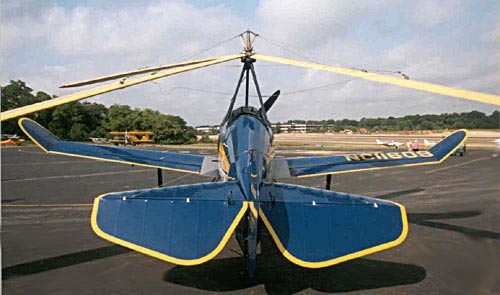AIRPLANES AND OTHER LOVELY OBJECTS

One of the rarest of all aircraft, the Pitcairn Autogyro. Only 20 were built, and this one remains. Even rarer is to see her fly, and at the hands of Stephen Pitcairn, the son of Harold, who's Pitcairn Aviation built her, she flies like a dream. To see this remarkable plane take off with nearly no run, climb like an eagle, and autorotate in, without a sound, is simply spellbinding. She has now been donated to the EAA Airventure Museum, where she'll be on display - but not flying. Those who've seen her fly will not forget it! Here is more information, from the EAA:
RARE PITCAIRN AUTOGYRO TO BECOME PERMANENT PART OF EAA COLLECTION
An extremely rare Pitcairn PCA-2 autogyro, which was a revolutionary aircraft when first introduced in the 1930s, will make its way to the Experimental Aircraft Association's annual convention for the first time in 19 years this summer. The aircraft will be part of the flying and showcase displays at the 53rd annual EAA AirVenture Oshkosh gathering, The World's Greatest Aviation Celebration, held July 25-31 at Wittman Regional Airport at Oshkosh.The Pitcairn autogyro, named "Miss Champion," will be flown by owner Steve Pitcairn on a three-day trip from New Jersey to Oshkosh to participate in EAA AirVenture 2005. Following the fly-in, the aircraft will become part of the permanent display at the world-class EAA AirVenture Museum. The return to the event is the first for the aircraft since its lone Oshkosh appearance in 1986. "Steve Pitcairn's autogyro is truly a magnificent aircraft and very significant in a historical sense, making it a marvelous addition to EAA AirVenture 2005," said Tom Poberezny, EAA president and AirVenture chairman. "We are also very excited to be able to place this autogyro in the EAA AirVenture Museum's permanent collection, where people can see this unique combination of fixed- and rotary-wing aircraft year round."
"Miss Champion" is scheduled to participate in flying demonstrations throughout AirVenture week, and will be part of the vintage aircraft displays featured on in front of the Vintage Aircraft Association's "Red Barn" headquarters, just south of the main AeroShell Square showcase ramp.
Pitcairn's father, Harold, built only 20 of the PCA-2 models in the early 1930s under agreement with Juan de la Cierva, the Spanish aviation pioneer who developed the autogyro. The aircraft uses propeller-driven thrust to pull the aircraft through the air, while unpowered rotorblades spin through the air, providing lift similar to a helicopter. The Champion Spark Plug Company purchased "Miss Champion" new in 1931, using it to lead that summer's Ford National Air Tour. In 1932, the aircraft flew to an autogyro altitude record of 21,500 feet. It was retired to the Chicago Museum of Science and Industry for display shortly afterward, and then sold to a New Jersey museum after World War II. Steve Pitcairn acquired the aircraft in the early 1980s and restored it, flying it to Oshkosh shortly after the restoration was complete in 1986, where it was an audience favorite at that year's EAA fly-in convention. Pitcairn aircraft already have a significant role within the EAA AirVenture Museum's collection. In the mid-1990s, the Pitcairn Hangar was built at the museum's Pioneer Airport, where current exhibits include the Pitcairn PA-39 autogyro (the lone existing example) and the Pitcairn Mailwing biplane, which was used for air mail delivery in the 1920s and '30s. "Because of my association with EAA, it seemed to be the logical and appropriate place for Miss Champion to go," said Steve Pitcairn, a longtime EAA member. Harold Pitcairn founded Pitcairn Aviation in the 1920s to fly mail routes for the United States government, using what was referred to as the "eastern air line" from New York to Miami. In 1929, Pitcairn sold the air routes to concentrate on aircraft manufacturing and the new route owners renamed the business, which included passenger service, as Eastern Air Transport. It later became known as Eastern Airlines. EAA AIRVENTURE OSHKOSH is the world's greatest aviation celebration. For more information on EAA and its programs, www.eaa.org.
All photos are copyright 2006, Peter Jensen, under the DMCA
